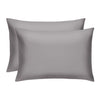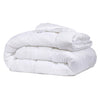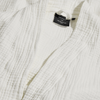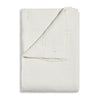
Linen is a popular material known for its quality and versatility. Whether you’re shopping for new napkins, summer clothes, or even curtains, you will likely find many linen options available.
Unfortunately, linen can also be a bit more of an investment. Paying more for quality isn’t a bad thing, but before you take the plunge, make sure you know what linen is and how to properly care for it.
One of the most unfortunate things about linen is that it does have a tendency to shrink. Thankfully, if you spend a little time and effort understanding the fabric and washing instructions, you can avoid the inconvenience of a shrunken shirt, towel, or bed sheet.
What Is Linen?
We often throw around fabric names just based on what we commonly see in stores without actually knowing what these words mean. If you’re wondering what linen actually is and where it comes from, you’re in the right place.
Linen is a fiber created naturally from the flax plant. Flax seeds are small and brown, but the flax flowers are actually quite a lovely blue color.
Once the plant is harvested, it goes through a process that includes drying, crushing, and beating. Ultimately, it is woven into fine linen. There is a rich history of flax use in textiles, dating back all the way to Ancient Egypt. Its popularity has grown over time, and today, most people use some type of linen in their everyday lives.
One major benefit of linen is its cooling effect. This makes it a popular choice for summer clothes or summer bed sheets, as it can help avoid overheating. Overheating is one of the reasons that many people have trouble getting good quality sleep, especially during the hotter months of the year.
Does Linen Shrink?
If you’re looking for a low-maintenance fabric, you may want to skip linen. Unfortunately, linen does shrink, and it shrinks fairly easily. Linen gets softer over time as you wash and use it, but it also is prone to shrinking.
The first time linen is washed, it can potentially shrink between 3-4%. This can be tricky, especially if you’re buying clothes and are trying to find the right size. Thankfully, some manufacturers will wash the linen before they even sell it, so the size you think you’re buying will be more accurate.
If this is the case, it will likely be clearly marked as pre-washed linen or pre-shrunk linen. This is the type you will want to get to avoid any unwelcome surprises upon your first wash.
Why Does Linen Shrink?
Now that you know that linen shrinks, you’re probably wondering why it shrinks. What about linen makes it so prone to shrinking over time? The answer takes us back to the flax plant that it is made from.
When the plant fibers from flax are used to make linen, they are stretched out, causing them to seem larger. They are firm and rigid. However, something called relaxation shrinkage can occur, which causes the fibers to relax and return to their original size.
The main cause of linen shrinkage is improper care and washing. If you wash your linens in hot water and then dry them on the hottest setting, you can bet that your linens will shrink fairly drastically.
Shrinking linen can be avoided. However, it takes some extra time and effort, especially when it comes to bedding. If that isn’t something you’re interested in, you may want to look into something a bit more convenient to care for, like silver-infused sheets.
But if you’re ready to learn more about linen, read on!
How To Properly Care for Linen
If you’re up to the challenge, it is possible to keep linen from shrinking. Simply take some extra time to provide proper care to your items. Thoroughly read the washing and drying instructions on the tag for your specific linen, as the instructions may vary.
For a general look, here are a few tips that will help you care for your linen:
To Wash Linen:
- Separate your linens from the rest of your items, and wash light and dark linen separately as well.
- Wash all linen in cold water. This is key to avoiding shrinkage.
- Wash your linen on the gentle cycle.
If You Prefer Handwashing:
- Use a small amount of gentle detergent and mix it with cold water in your sink or tub.
- Spend ten minutes soaking your linens.
- Move your linens around in the sink or tub very carefully. Avoid twisting or pulling on the material, as this can actually cause more damage and shrinkage.
To Dry Linen:
- Avoid high heat when drying linen.
- If you would like to use your dryer, be sure to select a low-heat cycle.
- Remove your items while they are still damp, and hang them to dry.
Linen is a great fabric, but it may wrinkle easily. To try and keep the wrinkles away, you may iron your linen on the lowest setting while the piece is still slightly damp.
Can You Un-Shrink Linen?
Did you know that only about 35% of Americans actually read the wash instructions on their clothes, sheets, and other items? Approximately 42% claim to read them sometimes, with the honest bunch of 22% admitting they rarely or never read the instructions.
Suppose you’re part of that group and skipped the washing instructions, or you accidentally threw some of your linens in with other clothes. In that case, you may be wondering if there is any hope of restoring the linen to its original size. Thankfully, if you’re willing to put in a little time and effort, you can unshrink linen to an extent.
Here’s how:
- Rewash your item. Be sure to pay extra attention to the instructions this time.
- Skip the dryer.
- Hang dry your item.
- Wait until it is slightly damp and remove it from the line.
- Iron on the lowest setting, starting from the middle and applying slight pressure as you move outwards.
How is this possible? Think about the plant fibers once more. By washing your item and then ironing it from the center to the outsides, you’re stretching and strengthening out those fibers again. They are no longer as relaxed.
While it may be inconvenient and frustrating, it is pretty cool that this fabric reacts this way when you think about it. However, if you’re intimidated by the care needed for linen, there are always other options.
Alternatives to Linen
There are plenty of other fabrics you can use in your everyday life. We’ll stick to talking about the ones we know best, which are used to make towels, sheets, and comforters. First up is cotton. You can find some amazing sheets and towels made out of cotton, and they are easier to maintain than linen.
Other popular fabrics include:
- Bamboo
- Polyester
- Tencel
- Silk
- Satin
- Microfiber
Before you make your purchase decision, do some research to find out which one of these options works best for you.
Linen can be a great material, but it does require a good amount of care. It may shrink in the wash, but it is also possible to try out a few techniques to avoid shrinking or even get it back close to its original size.
As long as you are patient and pay attention to the guidelines, you’ll be able to use linen very successfully. Always remember to wash it in cold water and avoid high heat settings in the dryer!
Sources:
flax | Description, Fiber, Flaxseed, Uses, & Facts | Britannica
Relaxation Shrinkage | ScienceDirect Topics
Frequency of Reading Washing Instructions on Clothing Labels U.S. 2019 | Statista





























